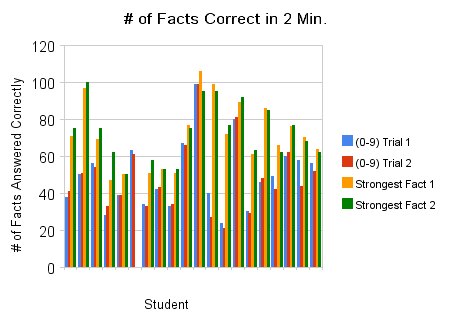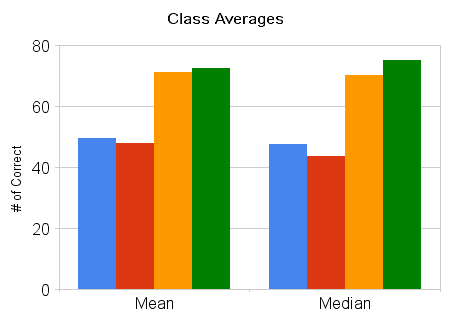My school is about to implement some sort of math facts fluency standards. This is probably a good thing when the majority of my students coming into the year had count up or down on their fingers when they are doing addition and subtraction. Not to mention 5th graders who still add 6 eight times to figure out 6 x 8. Yes, they figure out what 6 x 8 =, but it shouldn’t have to be that heard. At least in my opinion, it shouldn’t be. There is also research that shows when students have to apply brain power to figuring out basic facts, they miss out on higher level concepts.
Just saying that facts fluency should be part of the grade and handing out timed tests that have 150 problems is NOT the way to go about doing this. We need to figure out quite a few things before jumping in blind. Some questions I have in my head are:
- What is considered an acceptable percent correct? 80%? 90%? 95%?
- How many facts should a student be able to perform in the given time?
- How does this lend itself to traditional grades? Does it at all?
- How do you test for fluency?
- How often do you test?
Those questions are off the top of my head and I’m sure there are other issues.
My thoughts to the questions:
1. 90% seems right to me. If a student is doing this from memory and is missing more than 10%, they don’t know the facts. Right?
2. This is a tricky question and one which I will get into more below. I’m pushing for measuring it in facts per minute. Some teachers prefer the marathon facts quizzes of 200 problems while others prefer a test of 50. I lean to the side of 50 but have another reason for doing it per minute. (Question 4)
3. No clue how this can fit into a traditional grading scale. I’m not even sure it should be included in the grades, but many teachers feel that if it isn’t a grade the parents won’t support it at home.
4. My class uses That Quiz to practice our facts. Beautiful and simple set up. I can control the time, range, process, and the number of problems allowed. Then, it gives me a percent correct and shows any problems missed. Last, the kids love it. Compare this with a pencil and paper with 150 problems on it, which would you choose? Even better, I don’t have to grade through 2,000 simple facts to see how my students are performing. It tells them and me immediately.
5. Using That Quiz, I let them test anytime they can. I don’t have to grade any of them, only record their scores on my spreadsheet. Test all day, you’ll learn them eventually.
Coming together as a staff to discuss this, we’ll get 25-30 different responses to these questions. This is where data needs to come into play. Looking around briefly online, I honestly couldn’t find a lot of information. I found a few teacher sites where people said students should be able to do 90 problems in 2 minutes or 200 problems in 5 minutes. Their reasoning always seemed to be “that’s how I’ve always done it”. In an effort avoid this, I did some quick data collection with my students.
Giving my students two minutes to complete as many problems as they could, I recorded the number of facts correctly answered. I tested 4 times total, the first two tests were multiplication facts 0-9. For the last two tests, the students picked their best fact.
 And the mean and median of the results:
And the mean and median of the results:
 Now, what does this information mean? My class averaged just short of 50 problems in 2 minutes when testing all facts. On the strongest fact, our averages rose to just above 70.
Now, what does this information mean? My class averaged just short of 50 problems in 2 minutes when testing all facts. On the strongest fact, our averages rose to just above 70.
*Two interesting results: One student actually scored higher on the mixed than on best fact. Nothing big, this student had 4 of the top 6 scores. The other interesting result was “student m”, had one of the lowest results on the 2nd mixed test (27) and the 5th highest on the best fact test (99).
I would say 70 accurate responses in 2 minutes is very fluent. So, 35 problems per minute? Might be a touch too high, but I wouldn’t go much lower.
I don’t know if this says much of anything, but I’m going to continue to track this for the rest of the semester and see what comes out of it. Finally, hopefully this will help in our discussion on implementing facts testing.
Filed under: Does this help my students?, Math, Problem Solving | Tagged: data, math facts, PLC |


Leave a comment